|
Hurricane Ivan Journal Excerpts
[ Back ] [ Home ] [ Up ] [ Next ]
* * Click pictures to enlarge;
close out of that window to return to
this page * *
|
 |
|
TOBAGO |
|
Charlotteville,
TOBAGO


Breakfast
ashore

Lyda's softshell
crabs, with Jody & Bruce (s/v CaVa)

Tobago's national bird, cocrico - it's legal to kill and
tasty to eat!

Helping fishermen
pull nets; our anchorage in
background

A young French
cruiser

Our fresh caught
lobster dinner

Secluded Pirates'
Beach
|
TOBAGO, AUGUST 19 - SEPTEMBER 14,
2004: We make a 22-hour
overnight passage from the
Grenadines southeast to
Tobago in favorable easterly winds
but against 1.5 - 2.5 knot current
the whole way, creating a bumpy and
wet ride for us. After slowing
down during the night, we arrive
just at sun up.
We arrive in Tobago (not related to
Tobago Cays), our first time
here. Tobago, which has
exchanged hands more than any other
Caribbean island (about 30 times)
was shuffled off to Trinidad as part
of a political deal. They are
now an independent 2-island country.
Other than that, there is very
little similarity between these two
English-speaking islands, either geologically or
ethnically. We were told Tobago
and Trinidad are friendly to a
point, although Tobago feels like
they do not get their fair share of
the oil production revenues.
Tobago is a small (116 sq.
miles) mountainous island with a
population of 47,000 people.
Although a lovely get-away
destination, tourism is still light
and it is not a big hangout for
cruisers only because it is usually
a struggle to get here against the
wind and strong currents, and
untenable in winter months.
Things, and people, are unspoiled
here for the most part as they still
think of themselves as a colony: crime
is practically non-existent, locals
greet you ("yeh mon") on the street as if they
know you, nobody wants or expects
anything (i.e., $) from you, and
there are birds (like parrots)
galore all over the place.
At sunrise we arrive in the
large (2 mile x 1 mile) bay at
Charlotteville, TOBAGO,
on the northwest coast, and anchor
in deep 50 ft. of water. It's
always fun pulling into an anchorage
and recognizing boats - here, there
are
two boats, CaVa and Pastime, we know from St. Maarten,
and a couple other boats we know
come a few days later. The bay
is surrounded by steep, thickly
forested mountains with hanging rain
clouds and deep waters, good
snorkeling and several secluded
beaches nestled in between rock
outcroppings.
The woods are
filled with boisterous birds,
including lots of parrots, seen
regularly flying around.
Tobago boasts 210 species of nesting
birds, way more than any other small
island, and is one of the best
places for bird watching
aficionados. Once we awoke at
3:00 a.m. to a lively 20-minute
conversation among the hillside
inhabitants. Although Tobago's
national bird, the raucous cocrico (rufous-vented
chachalaca), a rather large brown
nondescript bird, is protected by
law, it's habit of eating
agricultural crops makes it legal to
shoot it if it's in your yard - it's
suppose to be mighty tasty, too.
Parrots also have a similar
reputation for destroying crops
(wasteful creatures - they take one
bite of a fruit and move on to the
next), and
thus it is legal to kill or export
parrots, although legal hassles make
the latter not a profitable option.
Tobago is a
primary nesting area for the
endangered leatherback turtles
obtaining a length of 8 ft., and the
loggerhead, oxbill and green
turtles. We missed seeing them
as nesting season is March - August.
As in most Caribbean
islands, goats, sheep and cows
wander around seemingly impervious
to vehicular traffic. If you
hit an animal, it's your fault for
hitting it but the owner's fault for
letting it roam near the road.
Typically, the animal's owner pays for your
car repairs and you pay for the
livestock loss. In Tobago an
added caveat is if you hit, for
example, a cow, you should
physically take hold of the other
cows until the police come. If
the owner does not pay for your car
repairs, then you get possession of
ALL the cows you hold. Of
course the owner will want the
others back, so this pretty much
guaranties your car will be repaired
at owner's expense. We hear
this law is enforced, and also helps
to keep animals away from roadways.
We found the people of Tobago
exceptionally friendly. But
even more unforgettable is how very
helpful (read 'not lazy') and pleasant every person is
here - probably more so than any
other island we have visited.
Trying to get a boat part shipped
in, a customs official spent half an
hour on a Sunday afternoon making
phone calls for us; another official a few
days later did the same thing.
We spend a very relaxing 2 weeks
in Charlotteville, eating the best
rotis in the Caribbean (at Lyda's),
hiking, snorkeling, beach BBQ,
reading and enjoying the serene
environment. (A "roti" looks
like a burrito filled with meat and
curried vegetables such at potatoes,
chick/garbonzo/channa peas, and
candied mango; a "buss 'n shut" is
served with the "skins" on the side
so you build your own.) A 6-ft
manta ray lives in the bay and
occasionally skims by boats.
Dinghying back from snorkeling,
several dozen dolphins were
frolicking in the bay. Jumping
in the water trying to get a closer
look, a friend saw 2 of them descend
past him together in a tight
vertical position, apparently doing
a mating ritual. It would be very
easy to stay here indefinitely.
The village is a main street along
the water's edge, with the basics
available except an ATM machine.
A 90-minute, US$1.50 scenic bus trip
through the mountains and along the
east coast into Scarborough gives us
access to big city amenities.
While here, we found out
that we
recently qualified as Commodores in
Seven Seas Cruising Association (SSCA),
having lived aboard for at least a
year and having made a passage of
1,500 miles.
 |
|
Buccoo Bay,
TOBAGO

Donston Johnson
from Buccoo Point, a big help during
Ivan

Old storm diagram,
but point can still be made:
Move ARGO to SOUTH side of storm -
the cleaner side - and that's where
we were during Ivan. [Editable
file deleted, thus stuck with this
one.]

Steve - resting
(temporarily) under
mosquito-netted lumpy bed after Ivan
passed |
Even though we are
south of the "hurricane belt", which
passes through Grenada (north of
Tobago), we stay alert to weather
forecasts. The last
hurricane to hit Tobago was 41 years
ago in 1963. Hurricane
IVAN holds the record for
forming as a tropical storm, and
turning into a hurricane, further
south than any other. Tropical
storms/hurricanes then turn to a
northwest course avoiding this area.
Ivan, however, was not turning
northwest as expected. (In
fact, the National Hurricane Center's predictions were off
every step of the way on Ivan.)
Tobago's
anchorages are not protected, and
the idea of being anchored in deep
50 ft. water in Charlotteville did
not appeal to us. Remember
from Charlie and Earl, we want to
put out as much "scope", or ratio of
anchor chain to depth, as possible.
On Monday morning, the day before
Ivan, ARGO and 4 other boats decided
to move southwest to Tobago's
southern end to put more distance
between us and Ivan's intended
track. The best anchorage is
Bon Accord Lagoon, but a couple of
the other boats, which draw at least
a foot less than we do, hit the
bottom and coral as they entered the
Lagoon. We decided this was
not a time to attempt the Lagoon's
entrance with Ivan bearing down
within 24 hours. We went
instead into Buccoo Bay,
although not well protected, is
somewhat hidden behind a reef, and
set 2 anchors. As we went to
bed that night, Ivan had turned to
the north.
We get up at 5:00
a.m. to find that Ivan's turn to the
north was only a temporary jaunt,
and that it is still on a due west
coarse. Although on this
course it would pass north of us
(putting us on the "cleaner" side)
we were still predicted to
experience hurricane force winds
(more than 75 mph near center) as
the eye passed within 48 miles of
ARGO. We set a 3rd anchor,
took off some canvas, left the sails
alone (time did not permit removing
them), and packed up the important
stuff like passport, boat papers,
insurance cards, money, credit
cards, computer et al, VHF radio,
flashlights, binoculars, camera, rain
jacket, clothes, shoes, clean
underwear, etc.. Next time I
would include the first aid kit and
the GPIRB. Not having been to
shore here, we dinghyed to a dinghy
dock and unloaded our bags feeling
like a vagabond, not sure where we
were going.
Turns out we
landed at little guest cottages, and
we took a room to store our stuff in
and stay overnight. The local
guys helped carry our heavy dinghy
and outboard up on land and tie to
trees; carried gas can, anchor etc.
to our room. The "bar" was
opened up and Steve "repaid" the
helpers with beer. You'd be
amazed how far a beer will go in
these places. Anyway, a very
small price to pay for such big
help. After exchanging "yeh
mon" with everyone, we hung out with
them watching the wind pick up,
trees bend backwards and the
corrugated tin roofs start to fly
off like boomerangs. As we
watched ARGO through the binoculars
buck violently like a bronco (is
that where Buccoo Bay gets it's
name?), we were prepared to lose her
- her bow and jib roller furling
were going all the way under water.
As Ivan passed, the wind would shift
and ARGO would swing around on her
anchors. It is always a
concern whether one anchor can trip
up another anchor . . . and set the
boat free.
The inn keeper had
the internet and TV up, so we could
see Ivan was still tracking towards
us, then the island lost power late
morning as Ivan was just
approaching the north coast of
Tobago. By early afternoon, we
had sought out alternate shelter
under the main building in a corner.
We were prepared to run for the
shower stall around the corner if
glass began to break. As it
turned out, even though Ivan was
less than 50 miles from us, we
probably saw only 50 - 55 knot winds
(56 - 63 mph). See storm
diagram at left. By mid
afternoon, we saw the wind shift and
knew Ivan had passed us, the worst
was over. We know how lucky we
were. Many of the locals,
however, are too young to know the
power of a hurricane and so they
thought it was just an interesting
phenomenon and good excuse not to
work.
This was the
very first night we have spent off
ARGO since leaving Houston one and a
half years ago: our "romantic
get-away" consisted of no
electricity, no water, a lumpy
mattress and rain blowing in under
the door! However, they did
cook a very nice dinner (rack of
lamb) for us and another couple,
served by candle light! We
returned to ARGO the next day and
found that all 3 anchors held and
she was dry inside. Great
relief.
|
|
GRENADA

Domino affect;
most jack stands were not tied
together
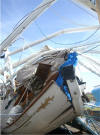

St. Georges
Lagoon: boats piled up onshore or sunk, lush
green hills now bare


Friend's boat holed during Ivan in Grenada,
arrived in Trinidad via barge |
|
Hurricane Ivan
Devastates Grenada

Via our
single-side band radio, and our
onboard email, we hear of Ivan's
direct hit on the south coast of
Grenada and the widespread damage
and destruction of 90% of the island.
Ivan was a Category 4 system with
sustained winds of 120 mph (104
knots) when it hit - the last direct
hit by a hurricane here was in 1955,
and not another for a half-century
before that. Unfortunately, many of our friends
were in Grenada (considered "hurricane safe"
by insurance companies and cruisers) and either
lost or have severely damaged boats.
Only a handful survived without
any damage.
There were
approximately 700 boats
in Grenada before Ivan, about half
of these were hauled out in one of
the two boat yards and the other
half afloat in marinas or
anchored/moored in harbors.
Out of the 197 boats at Spice Island
boatyard all but a very few fell
over, and only 3 were able to
float afterwards, we hear from a
friend who owns one of those 3
boats. Among all the boats afloat
in Grenada before Ivan, approximately one third
ended up sunk or aground.
Several catamarans
and trimarans we seen literally
flying through the air great
distances, clipping masts that stood
in their way in half - one catamaran
took out 3 boats' masts in its airborne
travel. (A pretty compelling
argument why not to stay on your
boat.) One friend saw a
neighboring boat break loose, wash
out to sea with the outgoing
current, only to see it return later
with the incoming current,
miraculously missing his boat, reefs
and other boats on its round trip
journey.
Grenada's
infrastructure was almost completely
destroyed: It lost all
electricity and communications
services, water supply became
contaminated, no gasoline or diesel
available, and police, emergency
services and medical facilities were
damaged beyond effectiveness.
Grenada instantly turned into a
lawless island, with rampant looting
ashore as well as of unattended
boats, relief supply barges from
other islands being hijacked by
armed pirates, and the US and
British governments telling everyone
to leave asap as they could not
provide security or protection.
The prison was heavily damaged so
all the really bad guys were walking
the streets, too, including several
of the men (serving life sentences)
responsible for massacring the prime
minister and his cabinet before a
firing squad back in the early
1980's. Gun shots were a
common sound, and scary, as Lower
Woburn (near Hog Island / Clarkes' Court
area) is home
of a mafia group.
The day after
Ivan, the Grenada Rescue Effort was
formed and able-bodied cruisers in
Grenada started assembling lists of
boats and crew, and their status
(afloat, aground, holed, sunk,
toppled over on land, etc.),
throughout the 10 or so harbors,
marinas and
boat yards. A concise,
alphabetical listing of 800 boats in the Grenada
area
with their status is [was] available on the internet.
Reports are that at least one
cruiser lost his life when his boat
broke loose and was taken out to
sea, his body washing to shore
later. (About 40 Grenadians
lost their lives.)
Simultaneously,
cruisers in Trinidad quickly formed
the Grenada Relief Effort,
collecting such things as diesel,
gasoline, food, water pumps, tarps,
items to patch holes in hulls, etc.
Cruisers sailed to Grenada loaded
down with supplies. Another
cruiser, s/v Zingano, took his catamaran with a high capacity water
maker, anchored offshore Grenada and made
water 24-hours a day for cruisers
for a few weeks. Other boats
laden with full diesel tanks and gerry cans went boat to boat giving
fuel as needed to run engines and
generators to keep batteries charged.
We understand from
stateside family and friends that
Ivan's destruction of Grenada was
barely
covered in the States. To help put it in
perspective, we have compiled emails
and log
from several friends who were in
Grenada during Ivan. We recommend reading their
chilling accounts, both during and
after Ivan, from emails and personal
log
-
Hurricane Ivan Journal Excerpts.
 |
|
GRENADA

Spice Island boat
yard



"Flying machine"
(catamaran) upside down; note
grounded & sunken boats in
background
  

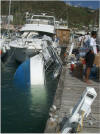
Unloading emergency
supplies off a Trinidad Relief boat |
|
Store Bay,
TOBAGO

Local
shoemaker making hat chinstrap for
Deborah

Hurricane
Ivan casualty left untouched by
locals in virtually crime-free
Tobago

Roachees,
our award-winning tour and bird
watching guide

"Can't you see the
bird, it's right there?"

Colorful blue crown motmot with it's
distinctive segmented tail |
Tobago,
continued -
It was unfortunate
we were not able to enjoy Buccoo Bay
more. It is known for their
annual Goat and Crab races at
Easter. Sunday School was
invented here - its for the
"parents" and entails a big street
party every Sunday night with lots
of food and music and drinking.
Sadly enough, we were not able to
attend Sunday School. We made
good friends in short time, and have
sent coveted Houston Texans t-shirts
to those who really helped us out
here in
a time of crisis.
The day after Ivan
we moved a little further south to
Store Bay and anchored in
front of a nice beach and resort
area, with easy access to laundry,
internet, stores and more.
Captain Phil (he's known for his own
commercial brand of West Indies hot
sauce down here called "Capt. Phil's
Wreck-tum Fire" - say it out loud)
organized a beach cookout with fresh
caught kingfish. From here we
took a day tour of Tobago, seeing
sights so far missed. With our
knowledgeable personal guide, we
hiked through the rain forest for a
bird watching outing, seeing many,
many different species of birds.
Not being big bird watching
enthusiasts, we very much enjoyed
the concise but fruitful experience.
We also hiked to a waterfall, and
along the way passed a large grove
of trees and bamboo filled with
squawking parrots. By the way, bamboo is
the world's largest grass growing 6 inches a
day during season. Unbelievably huge, tall stands of
bamboo attractively cover the
northern part of Tobago.
Some are now bent in half from
Ivan's force.
We learned some
interesting things about Tobago,
most of which probably apply to
Trinidad also. Each and every
town or village has its own Medical
Center providing free medical care.
In fact, foreign visitors are also
entitled to use these free services.
Welfare is available to those
citizens needing it, however, each
and every person receiving welfare
has to "earn" it. They perform
supervised services such as cleaning up beach
areas and roads (within a couple of
days of Ivan, crews had
picked up debris and fallen palm fronds,
branches, trees, etc), etc.
When there is nothing else to do,
they build small parks along
roadways or on scenic hillsides,
including benches and landscaping.
Consequently, there are a lot of
these parks all around, adding to
the appeal of this small island.
Many religions are
practiced here (human
sacrifices not allowed, our guide
told us), but
we have noted a lot of Seventh Day
Adventists - they do not work on
Saturdays. We also were told
that Tobago is a popular place for
Europeans, especially Germans and
Dutch, to have homes. Harrison
Ford also has a house here.
Store Bay does not
have any dinghy docks, so this is
one of those places where we have to
beach the dinghy.
Unfortunately, there is quite a big
surf here. Unequivocally, we
had our worst dinghy landing and,
subsequently, worst dinghy launch ever
(could call it "crash 'n burn" or
"surf 'n turf" or "surf 'n
submerge"). Going in, a big
wave caught us and pushed the dinghy
sideways as Steve is attempting to
pull us up onto the beach - this
resulted in him getting run over by
the dinghy (outboard is off, of
course, at this point). In
town he kept getting funny looks as
we couldn't get all the sand out of
his eye lashes and eye brows.
Leaving the beach later with 2 other
dinghies, we were first out, Deborah
and another gal pushing the dinghy
out - just as a big wave caught the
dinghy and dunked both of them
completely. It was
picture worthy as they surfaced
looking like drowned rats with straw
hat and sunglasses hanging limp.
Oh well, already wet, they assisted
the other 2 dinghies by swimming
them out beyond the breaking waves.
We learned here that timing IS
everything!
We had planned on
spending more time in Tobago, and
anchoring in several other
anchorages, but unfortunately Ivan
changed that. We encourage
anyone considering visiting Tobago
to do it, as it is a unique place in
many ways.
We leave Store Bay at 4:00 a.m., and
finally with wind and current going
with us, we make a pleasant
overnight passage southwest to neighboring
Trinidad . . . |
|
TRINIDAD |
|
|
|
 |
 |
 |
|
NORTH COAST:
rugged beauty |
SCOTLAND
BAY: secluded |
CHAGUARAMAS: only partially
visible, lots of sailboats here! |
TRINIDAD,
SEPTEMBER 14 - DECEMBER 11,
2004:
Trinidad is a high island and we are
able to see it from Tobago on a
clear day. We run along the
entire length of Trinidad's north
coast, with it's sheer cliffs and
thick forests, and go around it's
northwest point into Scotland Bay
for our first night. Normally,
we would be required to go into a
port of entry to clear into customs
and immigration immediately
(Trinidad & Tobago are very strict
about this), but due to all the
damaged boats coming from Grenada, they have
been very lenient in their
enforcement of timely clearance.
Scotland Bay offers a secluded
anchorage with parrots and howler
monkeys "disturbing" the peace and
quiet. Unfortunately, the
pretty scenery is marred by the
sight of floating trash - lots of
plastic, styrofoam - that comes and
goes with the tides, and litters the
beach. We had heard this from
others before hand, but was still
sickened by this sight. As it
turns out, trash is prevalent all
along Trinidad's coasts.
A short hop the
next day puts
us in Chaguaramas, a dominant
yachting service center in the E.
Caribbean. Being below the
"hurricane belt", many cruisers
store their boats here during
hurricane season,
and/or do major boat repairs and
maintenance here - services and labor prices are
substantially less than in the US.
Consequently, this is a natural
place for the boats damaged by Ivan
in Grenada to come - an overnight
passage south. Most marinas,
haul out facilities, boatyards,
chandleries and marine services are
located around a bay, all within
easy walking/dinghying distance.
This is a great place to have a bike
and we borrowed s/v Remedy's bikes
as needed. Other services
including laundry, internet,
banking, post
office, communication, restaurant,
bar and public transportation are
readily available at reasonable
prices. Port of
Spain, Trinidad's main city, is only
15 miles from Chaguaramas, providing
typical big city amenities.
It is easy to get from
Chaguaramas
to Port of Spain via the maxi-taxies
that run frequently and cost very
little, and so we have made numerous
trips in to the city for shopping,
errands, sightseeing, and
dentist/doctor appointments.
Trinidad boasts its world-renowned
Carnival - many cruisers will stay
here until afterwards, but we will
need to be further west by February
2005. It's easy to see how
cruisers can get stuck here for many
months - just another Hotel
California! post
office, communication, restaurant,
bar and public transportation are
readily available at reasonable
prices. Port of
Spain, Trinidad's main city, is only
15 miles from Chaguaramas, providing
typical big city amenities.
It is easy to get from
Chaguaramas
to Port of Spain via the maxi-taxies
that run frequently and cost very
little, and so we have made numerous
trips in to the city for shopping,
errands, sightseeing, and
dentist/doctor appointments.
Trinidad boasts its world-renowned
Carnival - many cruisers will stay
here until afterwards, but we will
need to be further west by February
2005. It's easy to see how
cruisers can get stuck here for many
months - just another Hotel
California!
We arrived
in Chaguaramas and hauled the boat
at Coral Cove Marina the
next day to do boat
maintenance and
repairs. We lived on the boat
while "on the hard" for 2 months:
We did rent an air conditioning unit
(our boat's A/C unit is water
cooled so can't run on the hard) as it is HOT and VERY HUMID
here. It is the rainy season
now so an afternoon shower is
typical. We did have a good
location next to the forest, so
parrots were a common sight (and
sound) in the early morning and
evening hours. Other than
climbing up and down the ladder, and
certain bathhouse needs, it wasn't
bad.
Trinidad is known
for its huge fabric industry, with a
section of downtown devoted strictly
to fabric and upholstery stores.
Prices are very, very cheap and many
cruisers take advantage of that to
redo their boat's upholstery and
canvas. At one of the marinas,
"swimsuit Debbie" and "Bernice-the-dress'n'shirt-maker"
come weekly and custom make clothes,
all you do is provide fabric, and a
sample to follow if desired.
Deborah had several swimsuits, wraps
and sundresses made,
typical cost of swimsuit: spandex fabric US$4
+ labor US$20. Not bad
for a beautifully made custom
swimsuit. We also had some other things
made, too, including some shirts for
Steve.
Yachties in
Chaguaramas are very lucky to have
Jesse James ("Members Only Maxi-Taxi
service, it's a name only"),
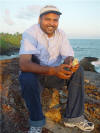 whose
reputation extends beyond the E.
Caribbean. He caters to the
cruising community like no other:
regularly scheduled shopping trips
(some free) to various stores, malls
and the open produce market (Sat.
6:30 am departure), tours (or come up with your
own and he'll make it happen),
drivers for personal use,
airport drop-offs/pickups,
reservation/ ticketing/
transportation for events, etc.,
etc. Anything you want he can
do for you, and at very
reasonable prices. whose
reputation extends beyond the E.
Caribbean. He caters to the
cruising community like no other:
regularly scheduled shopping trips
(some free) to various stores, malls
and the open produce market (Sat.
6:30 am departure), tours (or come up with your
own and he'll make it happen),
drivers for personal use,
airport drop-offs/pickups,
reservation/ ticketing/
transportation for events, etc.,
etc. Anything you want he can
do for you, and at very
reasonable prices.  He has been
very instrumental in the Grenada
Relief Effort coordinating supply
shipments and gathering
contributions from his church
community. Jesse's wife,
Sharon Rose, runs the office and they are always accessible in
person, by VHF or by phone. We
all seriously wonder when Jesse
sleeps, as he is very much a
hands-on guy, which ensures that
everything goes smoothly - and it
always does. (Jesse caught
a short snooze while we bird watched
at Asa Wright.) He is truly
an amazing person, and one of the
nicest and sincerest people you'll
ever meet. Thank you, Jesse,
for making our experience in
Trinidad safe, easy and most
enjoyable! He has been
very instrumental in the Grenada
Relief Effort coordinating supply
shipments and gathering
contributions from his church
community. Jesse's wife,
Sharon Rose, runs the office and they are always accessible in
person, by VHF or by phone. We
all seriously wonder when Jesse
sleeps, as he is very much a
hands-on guy, which ensures that
everything goes smoothly - and it
always does. (Jesse caught
a short snooze while we bird watched
at Asa Wright.) He is truly
an amazing person, and one of the
nicest and sincerest people you'll
ever meet. Thank you, Jesse,
for making our experience in
Trinidad safe, easy and most
enjoyable!
It is fun here as
there are so many cruisers that we
already knew, and have met so many new ones.
Trinidad is a typical point for a
cruiser to start and end their
circumnavigation. Consequently
we have met many cruisers who are
wrapping up their around-the-world
trip here. They are always
interesting, full of knowledge and
experience and a great motivator to
keep on moving! A cruising
couple put on a couple of day
seminars on cruising in the South
Pacific, attended by 80 people, a
clear indicator of those intending
to go through the Panama Canal -
some slated for spring 2005 and
others for spring 2006. As the
weather window for going into the
South Pacific is defined, one tends
to travel loosely with a finite
group, so it is nice meeting these
folks now.
Many cruisers come
to Chaguaramas and become obsessed
with boat work, leaving here without
ever really seeing the country or
culture of Trinidad. This
describes us our first month here.
However, after getting boat projects
lined up and going (we beat the
influx of damaged Grenada boats) we
made sure we got out and about. Through
Jesse, one day we visited the Asa
Wright Nature Center (lots
of birds) in the morning, and the Caroni Swamp for a late afternoon
boat trip through the swamp to see
the scarlet ibises roost at sunset.
The sky and trees are vibrant red with
thousands of these gorgeous birds.
Another day Jesse took us to a pan
(steel drum) factory where we
learned more than we wanted to know
about this Trinidadian tradition,
then to the Angostura factory.
(At right: Christophine - it's like
a squash - grown on the hillside on
wire trellises suspended high above
the ground) country or
culture of Trinidad. This
describes us our first month here.
However, after getting boat projects
lined up and going (we beat the
influx of damaged Grenada boats) we
made sure we got out and about. Through
Jesse, one day we visited the Asa
Wright Nature Center (lots
of birds) in the morning, and the Caroni Swamp for a late afternoon
boat trip through the swamp to see
the scarlet ibises roost at sunset.
The sky and trees are vibrant red with
thousands of these gorgeous birds.
Another day Jesse took us to a pan
(steel drum) factory where we
learned more than we wanted to know
about this Trinidadian tradition,
then to the Angostura factory.
(At right: Christophine - it's like
a squash - grown on the hillside on
wire trellises suspended high above
the ground)
The Angostura
factory makes the famous Angostura
Aromatic Bitters, along with rums
and other food products. This
is the only place in the world where
the Angostura Bitters is made - in fact, the
whole process is done in 1 room
only!
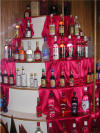 If you
are caught taking photos there is a
US$20,000 fine and
20 year imprisonment. They
mean business. Only 5 male
family members know the secret
formula and mix up the ingredients.
Moreover, Angostura has a special
arrangement with the Trinidadian
government whereby they can import
the raw ingredients into the country
without declaring the contents of
it. The secret botanicals from
around the world are collected in
the U.K. and then sent to Trinidad.
Bitters was originally concocted by
Dr. Siegert treating war injuries in
Prussia in the early 1800's.
He moved to Angostura, Venezuela and
began selling it in 1824, then moved
later to Trinidad with their special
sanctions. It is used to flavor
everything from alcoholic beverages
to soups, salads, vegetables,
sauces, fruits, desserts, etc..
Locals use it "medically" to treat
upset stomach, nausea, diarrhea and
constipation (how can it do both?), and more. There
are lots of imitation bitters on the
market, but only Angostura Bitters
floats on the surface when poured. If you
are caught taking photos there is a
US$20,000 fine and
20 year imprisonment. They
mean business. Only 5 male
family members know the secret
formula and mix up the ingredients.
Moreover, Angostura has a special
arrangement with the Trinidadian
government whereby they can import
the raw ingredients into the country
without declaring the contents of
it. The secret botanicals from
around the world are collected in
the U.K. and then sent to Trinidad.
Bitters was originally concocted by
Dr. Siegert treating war injuries in
Prussia in the early 1800's.
He moved to Angostura, Venezuela and
began selling it in 1824, then moved
later to Trinidad with their special
sanctions. It is used to flavor
everything from alcoholic beverages
to soups, salads, vegetables,
sauces, fruits, desserts, etc..
Locals use it "medically" to treat
upset stomach, nausea, diarrhea and
constipation (how can it do both?), and more. There
are lots of imitation bitters on the
market, but only Angostura Bitters
floats on the surface when poured.
Cultural
events, once again arranged
through Jesse,
included attending Pan Royale
Steelpan and Jazz Festival, a dressy
 occasion
outdoors at the Queen's Royal
College. It consisted of 4
diverse bands: one band occasion
outdoors at the Queen's Royal
College. It consisted of 4
diverse bands: one band
 featuring
some well-known, old but
highly energetic, jazz guru named the Black
Stallion; another was a 10-member
all-female Cuban jazz band (far
left) (they were entertaining to
watch and actually quite good when
they didn't sing); and an all-pan
band (left). Another event,
Jazz in the Yard (right), featuring
some well-known, old but
highly energetic, jazz guru named the Black
Stallion; another was a 10-member
all-female Cuban jazz band (far
left) (they were entertaining to
watch and actually quite good when
they didn't sing); and an all-pan
band (left). Another event,
Jazz in the Yard (right),
 was
arranged by a cruising
couple, Mood Indigo - Joyce is an
excellent professional jazz singer,
David plays the horn - and
put on in the
yard at the home of Michael Boothman,
an acclaimed jazz guitarist and
composer. Joining the 3 of
them were several other talented
musicians. This was a special
treat having such a great concert in
an intimate setting, and hearing
Mood Indigo as their reputation
precedes them in the cruising
community. A fun event was the
annual talent show at CrewsInn, one
of the big marinas here in
Chaguaramas. Seventeen of
their employees participated in a
professional-quality show with
talent that pleasantly surprised the
large audience of yachties.
Another was an annual local
marine-industry vendor sponsored
appreciation party outdoors with
each preparing different food dishes
and several bands playing - the food
was all very good, much to our
surprise, including an excellent
bouillabaisse, ceviche, seafood
kabobs, local curry dishes featuring
goat, deer, lamb, pork, and duck,
and plump cream puffs. was
arranged by a cruising
couple, Mood Indigo - Joyce is an
excellent professional jazz singer,
David plays the horn - and
put on in the
yard at the home of Michael Boothman,
an acclaimed jazz guitarist and
composer. Joining the 3 of
them were several other talented
musicians. This was a special
treat having such a great concert in
an intimate setting, and hearing
Mood Indigo as their reputation
precedes them in the cruising
community. A fun event was the
annual talent show at CrewsInn, one
of the big marinas here in
Chaguaramas. Seventeen of
their employees participated in a
professional-quality show with
talent that pleasantly surprised the
large audience of yachties.
Another was an annual local
marine-industry vendor sponsored
appreciation party outdoors with
each preparing different food dishes
and several bands playing - the food
was all very good, much to our
surprise, including an excellent
bouillabaisse, ceviche, seafood
kabobs, local curry dishes featuring
goat, deer, lamb, pork, and duck,
and plump cream puffs.
Trinidad's has a
very large Indian population.
November 11 was Divali, the Hindu
equivalent to our Christmas and New
Year. This signals the end of
their financial year and the end of
darkness (demons), and beginning of
the new. For the rest of us, it
signals the start of the party and
holiday season, and ramping up for
the huge Trini Carnival in February. The
Hindus celebrate Divali with the
Festival of Lights, copiously
decorating their houses, driveways
and streets with deyas, small
ceramic bowls filled with coconut
oil and a big wick which burns all
night, and electric lights.
Just as in the States there are
neighborhoods known for their
dazzling Christmas light displays
which prompts car loads of
sightseers, so does the village of
Felicity in Chaguanas on the west
coast of Trinidad. A bus caravan
of 175 yachties descended upon this
neighborhood in an organized manner.
The evening activities included a
swami-lead "sermon" and dance
program in a Hindu temple, a
sit-down typical Hindu vegetarian
dinner (channa/chickpeas & potatoes,
pumpkin, bread fruit type thing,
candied mangoes, spicey sauces and
roti skins for scooping up with the
fingers) served on a banana leaf,
wondering through the streets
looking at lights and people
watching (they are all dressed up in
their fine Indian costume).
The people were super friendly,
handing out bags of sweets called
parasec (?), a combination of
cream of wheat, milk, sugar and
something else. One bag I got
had an aromatic taste to it - must
have had Angostura Bitters in it.
We saw several temples including the
Hare Krishnas. Music
stages were set up on several street
corners. It was pretty
incredible seeing all the burning
deyas, but amazingly enough never
saw any uncontrolled fires or burning kids.
|
DIVALI
- HINDU CELEBRATION |
| |
|
|
|
 |
 |
 |
 |
|
Temple |
One of many lit up
streets |
Traditional dinner |
Another temple |
| |
|
|
|
 |
 |
 |
 |
|
Deyas, "candles" |
Young dancers |
Yard filled with
deyas displays |
Typical
house with hundreds of deyas, and
electric lights |
|
Lime,
liming:
A widely used
Trinidadian expression meaning
to hangout, a gathering, to
party, etc. "We were
liming at the beach." |
As if you haven't
figured out by now, Chaguaramas is a
pretty social place with hundreds of
cruisers here. Sometimes too
much so! There aren't many
places you can go where you won't
run into somebody you know.
Makes it a fun place, though.
Interestingly enough, there is no
one hangout or bar where people
lime, although, there are
various "activities" and BBQs
scattered around. The daily
half-hour net on VHF 68 includes
extensive social announcements as
well as Jesse's arranged activities, a help-needed segment, treasures
of the bilge (free or for
trade/barter) and other things to
make it pretty
 easy to get
into the swing of things in Chaguaramas.
We've participated in Sunday
afternoon dominoes, Wednesday night Trivia
Quiz,
Sunday night BBQ at Coral Cove for it's
"residents", and numerous other
local outings. Several friends
have rental cars so
have seen more of the island,
including the popular north coast
Maracas Beach (left, with Sue &
Robert (Sunday's Child) and
Jeff (Yocahu)).
We've had exceptional dinners at the
popular Indian, Thai and Chinese
restaurants in Port of Spain (all
excellent!), with free transportation
provided by some of the restaurants.
We've gone to the zoo, easy to get
into the swing of things in Chaguaramas.
We've participated in Sunday
afternoon dominoes, Wednesday night Trivia
Quiz,
Sunday night BBQ at Coral Cove for it's
"residents", and numerous other
local outings. Several friends
have rental cars so
have seen more of the island,
including the popular north coast
Maracas Beach (left, with Sue &
Robert (Sunday's Child) and
Jeff (Yocahu)).
We've had exceptional dinners at the
popular Indian, Thai and Chinese
restaurants in Port of Spain (all
excellent!), with free transportation
provided by some of the restaurants.
We've gone to the zoo,
|
FUN
AT THE ZOO |
|
|
|
|
|
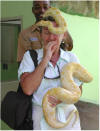 |
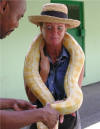 |
 |
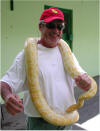 |
| Jo |
|
Dick |
|
|
Mustard, a
9-ft. albino boa constrictor, is
just a baby. Likes to have
his looong belly tickled.
Two zookeepers always present .
. . just in case he gets
frisky. |
botanical
gardens, movies, the U.S. Embassy to
vote (it was quick and easy, all we
needed were our passports), local boat
trip to nearby Caspar Grande island
to explore large caves and swim indoors
in crystal clear water.
| CAVES AT
CASPAR GRANDE ISLAND |
|
|
|
|
 |
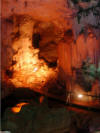 |
 |
| |
|
|
 A
group of cruisers joined another cruiser
on his catamaran to visit the island of Chacachacare for
snorkeling and exploring.
Chacachacare was a large
leper colony and when a cure for
leprosy was discovered about 35
years ago, this community was
literally abandoned overnight:
We saw readable medical records,
x-rays, vials and bottles of
medicine, and medical equipment
still in place, although nature is
doing it's share to reclaim it
(there is no
preservation/restoration program in
place). A
group of cruisers joined another cruiser
on his catamaran to visit the island of Chacachacare for
snorkeling and exploring.
Chacachacare was a large
leper colony and when a cure for
leprosy was discovered about 35
years ago, this community was
literally abandoned overnight:
We saw readable medical records,
x-rays, vials and bottles of
medicine, and medical equipment
still in place, although nature is
doing it's share to reclaim it
(there is no
preservation/restoration program in
place).
 During
our stay in Trinidad, we had an
unexpected visit from our good
friend Mark from Houston, a seasoned
sailor and cruiser. He had
been visiting Bob on s/v Sunrise
in Venezuela (while Susan was
tending to her new granddaughter in
Australia) and then he helped a
single-handed cruiser friend bring
her boat to Trinidad. Mark's
visit was cut short due to work
obligations but we did show him
around the area and Port of Spain in
a couple of days. During
our stay in Trinidad, we had an
unexpected visit from our good
friend Mark from Houston, a seasoned
sailor and cruiser. He had
been visiting Bob on s/v Sunrise
in Venezuela (while Susan was
tending to her new granddaughter in
Australia) and then he helped a
single-handed cruiser friend bring
her boat to Trinidad. Mark's
visit was cut short due to work
obligations but we did show him
around the area and Port of Spain in
a couple of days.
 We decide not to do the large
cruiser group dinner for
Thanksgiving
(those
who
attended last year were less than
impressed and felt rushed), but
instead 8 of us (s/v Remedy,
Yocahu, Quietly) have
our own dinner at the Coral Cove
cabana. Jo cooked a big
gourmet turkey and we had all the
traditional fixings. We decide not to do the large
cruiser group dinner for
Thanksgiving
(those
who
attended last year were less than
impressed and felt rushed), but
instead 8 of us (s/v Remedy,
Yocahu, Quietly) have
our own dinner at the Coral Cove
cabana. Jo cooked a big
gourmet turkey and we had all the
traditional fixings.
 Jeff
(right) made an impressive and
delectable antipasto tray served in
a Joe's pizza box that was
picture-worthy. Jeff
(right) made an impressive and
delectable antipasto tray served in
a Joe's pizza box that was
picture-worthy.
 Almost
overnight with Thanksgiving, the
weather has turned more pleasant -
daytime high
80's and only 90% humidity, less
rain -
Deborah has even started to wear
sleeved t-shirts again at night.
This was one "special"
occasion where Steve did
not have to wear long pants - all in
all, he has "dressed up" at least 6
times here in Trinidad - before
here, he's worn his long pants only
one time in almost 2 years!
(Right, Wendy & Janice from U.K.
visiting Yocahu & Quietly.) Almost
overnight with Thanksgiving, the
weather has turned more pleasant -
daytime high
80's and only 90% humidity, less
rain -
Deborah has even started to wear
sleeved t-shirts again at night.
This was one "special"
occasion where Steve did
not have to wear long pants - all in
all, he has "dressed up" at least 6
times here in Trinidad - before
here, he's worn his long pants only
one time in almost 2 years!
(Right, Wendy & Janice from U.K.
visiting Yocahu & Quietly.)
Most of what we
put on this website shows just the
fun stuff, but as every cruiser, or
even boat owner, knows there are
lots of things that can break on a
boat, and maintenance is an ongoing
job. Repairs and maintenance
consume a lot of our time, and our
pocket book, too. We spent a
couple of months in St. Maarten last
February/March getting caught up on
boat projects, repairs and
maintenance. Since then, the
list has grown again, and so here in
Trinidad we have spent
 much of our
time again doing repairs and
maintenance. We hired experts
to do certain jobs: Nigel Barker
(left) to do jobs like
repairing fiberglass dings and
scratches, touch up painting and a
bottom job; others to tune rigging,
some electrical issues, and work on
our transmission and engine.
Unfortunately, we had to replace our
transmission with a brand new
transmission due to a continually
worsening problem since St. Maarten.
This has been a very frustrating
experience for us as it took 2
marine service companies 2 months to
accurately diagnose the problem, and
a lot of finger pointing between
equipment manufacturers and false
promises. This has ended up
costing us an extra month on the
hard waiting for this issue to be
resolved, and in the end the whole
ordeal has cost us a lot of money.
But at least we now have a
dependable transmission. In
the meantime, we have cleaned/waxed
stainless, fiberglass, canvas, the
interior and more. We have
replaced worn lines and hardware,
stocked up on more rebuild kits and
cleaning supplies. We have had
the laptop much of our
time again doing repairs and
maintenance. We hired experts
to do certain jobs: Nigel Barker
(left) to do jobs like
repairing fiberglass dings and
scratches, touch up painting and a
bottom job; others to tune rigging,
some electrical issues, and work on
our transmission and engine.
Unfortunately, we had to replace our
transmission with a brand new
transmission due to a continually
worsening problem since St. Maarten.
This has been a very frustrating
experience for us as it took 2
marine service companies 2 months to
accurately diagnose the problem, and
a lot of finger pointing between
equipment manufacturers and false
promises. This has ended up
costing us an extra month on the
hard waiting for this issue to be
resolved, and in the end the whole
ordeal has cost us a lot of money.
But at least we now have a
dependable transmission. In
the meantime, we have cleaned/waxed
stainless, fiberglass, canvas, the
interior and more. We have
replaced worn lines and hardware,
stocked up on more rebuild kits and
cleaning supplies. We have had
the laptop repaired
again, but at least this time it
could be done locally. And of
course, we have been working at
updating the website which has now
gotten 3 months behind (due to Ivan,
boat work and computer problems
again) and a thousand pictures to go
through. We have fallen short
on this website of showing the
"down" side to cruising - I even
have a note posted on the boat to
"take work pictures", but always
forget when we're really into a job.
Too bad, because Trinidad certainly gave
us many opportunities for taking
these type pictures! Suffice
it to say, they wouldn't be pretty.
(OK, I got one picture here of Steve
working in the galley.) repaired
again, but at least this time it
could be done locally. And of
course, we have been working at
updating the website which has now
gotten 3 months behind (due to Ivan,
boat work and computer problems
again) and a thousand pictures to go
through. We have fallen short
on this website of showing the
"down" side to cruising - I even
have a note posted on the boat to
"take work pictures", but always
forget when we're really into a job.
Too bad, because Trinidad certainly gave
us many opportunities for taking
these type pictures! Suffice
it to say, they wouldn't be pretty.
(OK, I got one picture here of Steve
working in the galley.)
Even as we try
to leave now (first week of
December), we find we have a problem
with our water maker (need new
membranes) and dinghy outboard
(crank shaft problem), so currently
waiting on parts - we don't want to
leave here without these things
fixed, as parts and services will be
more scarce where we are headed.
 We have really enjoyed our stay in
Trinidad, experiencing the island, Trini
people, and the large cruiser
community. As hurricane season
ends in November, unless one is
staying for Carnival in February,
cruisers typically start leaving
now, heading either north up through
the island chain, or west to
Venezuela and on to the Panama Canal
and Western Caribbean. We wish we
could stay for Carnival, but it is time to
move on. When we leave,
hopefully this coming week, we'll
do on overnight sail to Isla de
Margarita, Venezuela . . . We have really enjoyed our stay in
Trinidad, experiencing the island, Trini
people, and the large cruiser
community. As hurricane season
ends in November, unless one is
staying for Carnival in February,
cruisers typically start leaving
now, heading either north up through
the island chain, or west to
Venezuela and on to the Panama Canal
and Western Caribbean. We wish we
could stay for Carnival, but it is time to
move on. When we leave,
hopefully this coming week, we'll
do on overnight sail to Isla de
Margarita, Venezuela . . .
Janice visiting from
U.K.

|
|
|
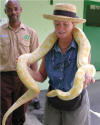 Getting the hang of
it . . .
Getting the hang of
it . . .
|
|
|
|
|
Hurricane Ivan Journal Excerpts
[ Back ] [ Home ] [ Up ] [ Next ]
[ Top of page ]
|
![]()